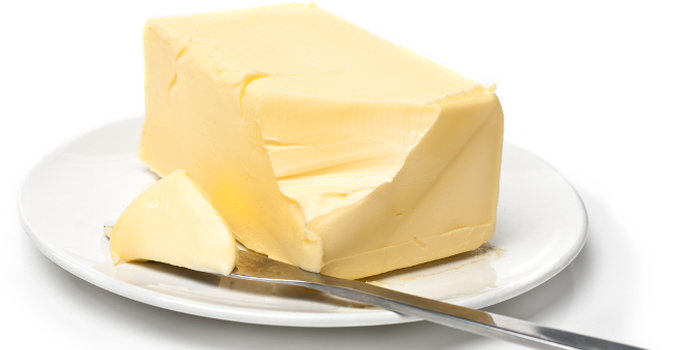The origins of butter date back to nearly 4500 years ago, when directions on how to make butter were illustrated on a limestone tablet. Butter is a concentrated form of whole milk. It is typically made from cow's milk, but it can also be created from goat and sheep milk.
How is Butter Made?
Dairies make butter by letting milk sit in large vats in a cool place, allowing for the cream to rise to the top. The cream is then skimmed off and moved to a separate vat. This cream is then usually allowed to sit so that acids form on the top, which helps break down the fat and give the butter a slight sour taste.
Butter is made by beating cream. Cream is the fatty and thickest part of milk. As the cream is beaten, the fat begins to stick together. This forces the cream to create a solid mass known as milk fat. This milk fat is what you know as butter. The byproduct of churning butter, or the liquid that is remaining, is buttermilk.
Nutritional Value of Butter
Commercial butter is composed of 80 to 82% fat, 16 to 17% water and 1 to 2% curd or other solids. Some butter contains salt, which makes up 1 to 2% of the butter.
Butter contains protein, calcium and phosphorus. The main vitamins in butter include vitamin A, vitamin D, vitamin E and vitamin K. Additional nutrients in butter include fatty acids, lactones, methyl ketones and dimethl and diacetyl sulfide.
Varieties of Butter
There are two main types of butter: traditional butter and fresh butter. Traditional butter is usually made from sour milk. This has a slightly more sour flavor than fresh butter. Fresh butter utilizes fresh cream and has a sweeter flavor.
There are several varieties of commercial butter on the market. These include sweet cream butter, reduced fat or light butter, salted and unsalted butter. Unsalted butter is often referred to as sweet butter, which is different from sweet cream butter.
Health Benefits of Butter
While butter is high in fat, this fat features heart-healthy fats, which have shown to lower cholesterol, prevent certain cancers and prevent the spread or growth of tumors. Butter is one of the easiest forms of vitamin A to absorb. Vitamin A promotes good vision, a healthy thyroid and adrenal health.
Butter contains antioxidants, specifically selenium, which helps protect the body from free radical damage. Additionally, butter contains iodine, which has shown to support the thyroid gland.
Cooking and Butter
When cooking with butter, you will notice that this fat creates a nutty flavor. It is an excellent choice for sautéing foods and for baking. Butter has a smoke point of 265 degrees F, making it one of the lowest smoke points of any form of fat.



